High Peaks Pure Earth presents the Summer 2021 Tibet Reading List! We’ve updated the previous Winter Reading List to include 31 more titles covering the span of the entire Tibetan Buddhist world.
If you think we’ve missed anything or if you have a particular recommendation please feel free to get in touch with us, it’s impossible for us to keep track of all Tibet-related publications! You’re also welcome as always to write your own short reviews in the comments section or on your social media, just tag us so that we see it or use the #TibetReadingList.
We’ve continued to add links to Bookshop.org, if you buy books linked to our site, we may earn a small commission and at the same time, their fees support independent bookshops! Where publications are not available on Bookshop, Amazon links are provided for convenience.
See below for the new books added to the existing Tibet Reading List. For ease, for the first time we have (broadly) categorised them.
Happy reading this summer and please continue to stay safe!
Buddhism
“Under the Shadow of White Tara: Buriat Buddhists in Imperial Russia” By Nikolay Tsyrempilov
From the publisher’s website:
The book offers an advanced overview of the relations that existed between the Buriat Buddhists and the Russian imperial authorities. Various institutions and actors represented Russian power: foreign and interior ministries, the Irkutsk general-governorship, the Orthodox Christian mission of East Siberia, local journalists and academic scholars. The book is focussing especially on the evolution of imperial legislation and specific administrative mechanisms aiming at the regulation of Buddhist affairs.
The author demonstrates how these actors responded to conflicting situations and collisions of interests. Thus the history of relations between Russia and her Buddhist subjects is shown as a complex process with participation of a number of actors with their own interests and motivations.
Order on Amazon here: https://amzn.to/3x9YvTo
“The Dalai Lama and the Nechung Oracle” By Christopher Bell
From the Oxford University Press website:
Tibetan Buddhism and the Dalai Lama enjoy global popularity and relevance, yet the longstanding practice of oracles within the tradition is still little known and understood. The Nechung Oracle, for example, is believed to become possessed by an important god named Pehar, who speaks through the human medium to confer with the Dalai Lama on matters of state. The Dalai Lama and the Nechung Oracle is the first monograph to explore the mythologies and rituals of this god, the Buddhist monastery that houses him, and his close friendship with incarnations of the Dalai Lama over the centuries.
In the seventeenth century, during the reign of the Fifth Dalai Lama, the protector deity Pehar and his oracle at Nechung Monastery were state-sanctioned by the nascent Tibetan government, becoming the head of an expansive pantheon of worldly deities assigned to protect the newly unified country. The governments of later Dalai Lamas expanded the deity’s influence, as well as their own, by establishing Pehar at monasteries and temples around Lhasa and across Tibet. Pehar’s cult at Nechung Monastery came to embody the Dalai Lama’s administrative control in a mutual relationship of protection and prestige, the effects of which continue to reverberate within Tibet and among the Tibetan exile community today. The friendship between these two immortals has spanned nearly five hundred years across the Tibetan plateau and beyond.
Available on Bookshop here: https://uk.bookshop.org/a/4863/9780197533352
“Bringing Buddhism to Tibet: History and Narrative in the DBA’ BZHED Manuscript” By Lewis Doney (ed.)
Note: This title is Open Access
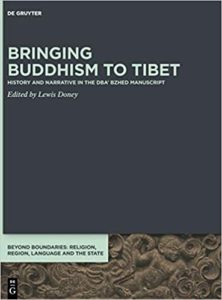
Published in 2021 by De Gruyter, “Bringing Buddhism to Tibet” is a landmark study of the Dba’ bzhed, a text recounting the introduction of Buddhism to Tibet.
From the De Gruyter website:
The narrative of Buddhism’s arrival in Tibet is known from a number of versions, but the Dba’ bzhed—preserved in a single manuscript—is the oldest complete copy. Although the Dba’ bzhed stands at the head of a long tradition of history writing in the Tibetan language, and has been known for more than two decades, this book provides a full transcription of the Tibetan for the first time, together with a new translation.
The book also introduces Tibetan history and the Dba’ bzhed with several introductory chapters on various aspects of the text by experienced scholars in the field of Tibetan philology. These detailed studies provide analysis of the text’s narrative context, its position within traditional and current historiography, and the organisation and structure of the text itself and its antecedents.
Bringing Buddhism to Tibet is essential reading for anyone interested in Tibetan history and kingship, the nature of Tibetan historical narrative or the traditions of text transmission and codicology. The book will also be of general interest to students of Buddhism and the spread of Buddhism across Asia.
Available for download here: https://www.degruyter.com/view/title/591555
“Tibetan Histories: A Bibliography of Tibetan-Language Historical Works” By Dan Martin
Note: This title is Open Access
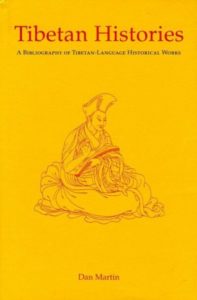
The newest edition of Dan Martin’s classic work “Tibetan Histories” was published earlier this year on the website of the Buddhist Digital Resource Center.
From the BDRC website (visit the site for book download links):
For close to 25 years now, a leading resource in Tibetan Studies has been Dan Martin’s Tibetan Histories: A Bibliography of Tibetan-Language Historical Works, Serindia Publications (London 1997). An early review of the book extols it by saying, “Tibetan Histories should be on the desks of all Tibetanists, at arm’s length and ready to enrich our studies.” The first edition of this book predated the digital age of Tibetan studies—for instance TBRC’s website was not launched until several years after its publication—but Dan Martin saw Tibetan Histories as an evolving document and has released multiple digital versions of an “Addenda & Corrigenda.”
The bibliographical content of the original book and the most recent version of the Addenda & Corrigenda have now been merged into a new digital edition of Tibetan Histories with detailed entries of over 1250 titles of Tibetan-language historical writings. This feast for scholars is enriched with an entirely new introductory survey of Tibetan-historical literature written by Dan Martin, which will immediately become a must-read in its own right. Dan Martin has very generously offered BDRC the privilege of hosting the new edition of Tibetan Histories.
“A Buddhist Sensibility: Aesthetic Education at Tibet’s Mindröling Monastery” By Dominique Townsend
From the Columbia University Press website:
Founded in 1676 during a cosmopolitan early modern period, Mindröling monastery became a key site for Buddhist education and a Tibetan civilizational center. Its founders sought to systematize and institutionalize a worldview rooted in Buddhist philosophy, engaging with contemporaries from across Tibetan Buddhist schools while crystallizing what it meant to be part of their own Nyingma school. At the monastery, ritual performance, meditation, renunciation, and training in the skills of a bureaucrat or member of the literati went hand in hand. Studying at Mindröling entailed training the senses and cultivating the objects of the senses through poetry, ritual music, monastic dance, visual arts, and incense production, as well as medicine and astrology.
Considering laypeople as well as monastics and women as well as men, “A Buddhist Sensibility” sheds new light on the forms of knowledge valued in early modern Tibetan societies, especially among the ruling classes. Townsend traces how tastes, values, and sensibilities were cultivated and spread, showing what it meant for a person, lay or monastic, to be deemed well educated. Combining historical and literary analysis with fieldwork in Tibetan Buddhist communities, this book reveals how monastic institutions work as centers of cultural production beyond the boundaries of what is conventionally deemed Buddhist.
Available on Bookshop here: https://uk.bookshop.org/a/4863/9780231194877
“Voices from Larung Gar: Shaping Tibetan Buddhism for the Twenty-First Century” By Holly Gayley (Ed.)
From the Shambhala website:
The book offers a compelling vision for Buddhism in the twenty-first century by some of the most erudite, creative, and influential Tibetan Buddhist luminaries today. In everyday language, these leaders delve into an array of contemporary issues, including science, ethics, gender equity, and animal welfare.
This collection features contributions from a range of prominent figures who are forging dynamic, modern paths forward for an ancient tradition. Included are the internationally renowned Khenpo Jigme Phuntsok, founder of Larung Gar, his distinguished successors Khenpos Sodargye and Tsultrim Lodro, and erudite nuns holding the scholarly title Khenmo, who are becoming known for their impressive publishing projects. Larung Gar is thus one of Tibetan Buddhism’s most vital communities, actively balancing cultural preservation and innovation.
Available on Bookshop here: https://uk.bookshop.org/a/4863/9781611808940
“Chörten in Nepal: Architecture and Buddhist Votive Practice in the Himalaya” By Niels Gutschow
From the DOM website:
For more than two millennia Buddhism shaped the cultures of Central, South, Southeast, and East Asia. From ancient Bactria and Gandhara to Tibet, Mongolia, and Japan, from Sri Lanka and Myanmar to Thailand, Cambodia, and Laos, each territory had its own peculiar way of developing representations of the Buddha, the Bodhisattvas, and a variety of guardian deities and saints.
Called Stupa in Sanskrit, Caitya in Nepali, Cibha in Newari, and Chörten in Tibetan, these structures – whether imposing or in miniature size – not only characterise the urban space of the Newars in the Kathmandu Valley. They also mark the access to Tibetan villages in northern Nepal, line the trails across high passes, and stud topographically prominent places. By their thousands, they transform wilderness into a landscape that promises shelter, protection, and well-being. Often, these structures are small, made up of two or three cubes in diminishing size, placed on top of one another. Of particular importance are the Triple Protectors, the Rigsum Gönpo, in the shape of three multiple cubes, lined up to guard the settlements against calamities such as floods, landslides, pests, and plagues. To ensure their agency, their colours (black, white, red) are annually renewed. Single cubes may also signal their significance as repositories of relics or the ashes of the departed.
584 maps, architectural drawings, and photographs, produced from 1970 to 2008, document the rich cultural heritage of the Tibetan and Tamang enclaves along the range of the high Himalaya.
Available on Amazon here: https://amzn.to/3x7CC76
““I Hear Her Words: An Introduction to Women in Buddhism” By Alice Collett
From the Windhorse Publications website:
Is there gender equality in Buddhist traditions? What do Buddhist texts say about women? Do Buddhist ethics support prejudice against women? Are there Buddhist doctrines that imply that women are inferior to men?
Scholarship on the topic of women and Buddhism has exploded in the last few decades and this book is an accessible survey of recent research. It offers an introduction and overview on women in Buddhism aimed at the interested reader and student.
Collett shows that core Buddhist doctrines and ethical formulations provide no justification for the notion that women are inferior to men. But Buddhism was born and took root in ancient and medieval societies that held traditional views of women. In this way social and cultural norms that position women as inferior to men found their way into Buddhist tradition and some Buddhist texts. Certain of these views became mainstays of the tradition, such that members of Buddhist communities have, throughout history, attempted to subjugate women.
This book offers unique access to the more rarely told histories of the many inspiring Buddhist women who fought against attempted constraint, often in the calmest and most compassionate ways imaginable; that is, simply by being themselves. From examples of women who were direct disciples of the historical Buddha, through Sri Lanka, Cambodia, Burma, Thailand, China, Japan, Korea, Taiwan and Tibet, to Buddhist women today, we hear about the many female exemplars of Buddhist tradition who became devoted disciples, innovative leaders and esteemed teachers. Not only do we hear about them in this book, but we also hear from them in their own words.
To ignore the contributions of such women to Buddhist tradition hides from view the history, struggles and liberation of the many women who have shaped and continue to shape Buddhist tradition.
Available on Bookshop here: https://uk.bookshop.org/a/4863/9781911407713
“The Sakya Jetsunmas; The Hidden World of Tibetan Female Lamas” By Elisabeth Benard
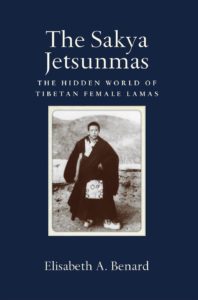
Originally published in January 2021, “The Sakya Jetsunmas; The Hidden World of Tibetan Female Lamas” by Elisabeth Benard is the first full treatment of the role of remarkable women in the Sakya school of Tibetan Buddhism.
Although the first print run of this book has sold out, according to the website of the Sapan Fund, the ebook and second printing will appear from Shambhala Publications in April 2022.
Biography
“A Childhood in Tibet: A Biography” By Thérèse Obrecht Hodler
From the Penguin website:
Tendöl Namling turned 60 in March 2019. She was born at the time when the Dalai Lama fled from Lhasa and the uprising of his people by the Chinese People’s Army was brutally suppressed. She has lived for 22 years under Chinese rule. As the daughter of a high government official, she underwent the ordeal of ‘re-education’ with full force. All she has kept from these years are painful memories and some crumpled photographs. They show her with her friends and cousins in Lhasa, smiling as if nothing had happened. When Tendöl turned 10 her brother was arrested and her mother sentenced to ten years in prison. Tendöl was sent to work in road construction for several years. At the age of 20 she was allowed to start an apprenticeship as motor mechanic. Thanks to the efforts of her family in exile, Tendöl was able to leave Tibet in 1982. After twenty years of hardship she landed in prosperous Switzerland. It felt as if she had to start her life all over again. She struggled but she never gave up. She founded a family and a business and reconciled herself with the painful past.
In Tendöl’s words, ‘this little book is dedicated to all the Tibetans who continue to rebel against the Chinese occupation’.
Available on Amazon here: https://amzn.to/2V7gGvL
“Road to Freedom — A Journey from Occupied Tibet: The True Story of the Search, Discovery, and Escape of a Reincarnate Lama” By Marya Waifoon Schwabe
Published in November 2020 by Luminare Press,”Road to Freedom — A Journey from Occupied Tibet: The True Story of the Search, Discovery, and Escape of a Reincarnate Lama” is the story of Nechung Rinpoche.
In accordance with the Tibetan tradition of finding the reincarnations of high lamas, the guidance of His Holiness the Dalai Lama was sought to locate the rebirth of Nechung Rinpoche, who passed away in 1983. Rinpoche is the eminent lama of Nechung, the institution that houses the Chief State Oracle. His Holiness gave several clues: the year of the boy’s birth, the names of his parents, and the locale of Lhasa, the capital city of Tibet. A search party of three people—a monk from Nechung Monastery in India, Marya and Miguel—made journeys to Tibet in 1987 and 1993. Their search led them to sacred visionary lakes and ancient monasteries. The expeditions were precarious and filled with challenges such as where to look, whom to trust, and how to accomplish a nearly impossible mission in a Chinese communist-occupied country where surveillance was prevalent. Ultimately, the escape with the eight-year-old lama entailed crossing multiple heavily guarded checkpoints, including two international airports.
Available on Amazon here: https://amzn.to/375BN4b
Literature
“Lineages of the Literary – Tibetan Buddhist Polymaths of Socialist China” By Nicole Willock
Published in April 2021 by Columbia University Press, “Lineages of the Literary” looks at three Tibetan Buddhist scholars, renowned as the “Three Polymaths,” Tséten Zhabdrung, Mugé Samten and Dungkar Lozang Trinlé (1927–1997) who earned their symbolic title for their efforts to keep the lamp of the Dharma lit even in the darkest hour of Tibetan history.
From the Columbia University Press website:
“Lineages of the Literary” reveals how the Three Polymaths negotiated the political tides of the twentieth century, shedding new light on Sino-Tibetan relations and Buddhism during this turbulent era. Nicole Willock explores their contributions to reviving Tibetan Buddhism, expanding Tibetan literary arts, and pioneering Tibetan studies as an academic discipline. Her sophisticated reading of Tibetan-language sources vivifies the capacious literary world of the Three Polymaths, including autobiography, Buddhist philosophy, poetic theory, and historiography. Whereas prevailing state-centric accounts place Tibetan religious figures in China in one of two roles, collaborator or resistance fighter, Willock shows how the Three Polymaths offer an alternative model of agency. She illuminates how they by turns safeguarded, taught, and celebrated Tibetan Buddhist knowledge, practices, and institutions after their near destruction during the Cultural Revolution.
An interdisciplinary work spanning religious studies, history, literary studies, and social theory, “Lineages of the Literary” offers new insight into the categories of religion and the secular, the role of Tibetan Buddhist leaders in modern China, and the contested ground of Tibet.
Available on Bookshop here: https://uk.bookshop.org/a/4863/9780231197076
“Revolute” By Tsering Wangmo Dhompa
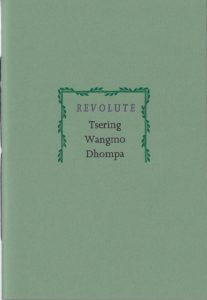
Published in April 2021 by micropress Albion Books, this poetry chapbook by Tsering Wangmo Dhompa contains 29 poems. Sadly, the chapbook is already out of print! Read a recent work by Tsering Wangmo Dhompa “Observations from the conqueror’s diary” on The Nation.
“The Selfless Ego: Configurations of Identity in Tibetan Life Writing” Edited By Lucia Galli, Franz Xaver Erhard
Published by Routledge in February 2021, “The Selfless Ego” is an essay collection that propose an innovative approach to one of the most fascinating aspects of Tibetan literature: life writing.
From the Routledge website:
Departing from past schemes of interpretation, this book addresses issues of literary theory and identity construction, eluding the strictures imposed by the adoption of the hagiographical master narrative as synonymous with the genre.
The book is divided into two parts. Ideally conceived as an ‘introduction’ to traditional forms of life writing as expressed in Buddhist milieus, Part I. Memory and Imagination in Tibetan Hagiographical Writing centres on the inner tensions between literary convention and self-expression that permeate indigenous hagiographies, mystical songs, records of teachings, and autobiographies. Part II: Conjuring Tibetan Lives explores the most unconventional traits of the genre, sifting through the narrative configuration of Tibetan biographical writings as ‘liberation stories’ to unearth those fragments of life that compose an individual’s multifaceted existence.
This volume is the first to approach Tibetan life writing from a literary and narratological perspective, encompassing a wide range of disciplines, themes, media, and historical periods, and thus opening new and vibrant areas of research to future scholarship across the Humanities.
The chapters in this book were originally published as two special issues of Life Writing.
Available on Bookshop here: https://uk.bookshop.org/a/4863/9780367693985
Politics and History
“The Fifth Dalai Lama And His First Three Administrators” By Sean Jones
Published by Vajra Books in March 2021, “The Fifth Dalai Lama And His First Three Administrators” by the late Sean Jones, is an attempt to elucidate some aspects of the political life of the Fifth Dalai Lama (1617-1682) who established the Ganden Phodrang, his government in the 17th century in Tibet, and especially his relations with the first three administrators (Desi).
From the Vajra Books website:
For the elucidation the book draws mainly from the English translation of the autobiography of the Fifth Dalai Lama (The Illusive Play, Serindia Publications 2014) and contains a vivid account of the lives of the first three administrators of the Fifth Dalai Lama that had remained until now very little known.
The author’s historical account of the lives of these monk officials is based on the personal observations made by the Fifth Dalai Lama in his autobiography.
Desi Sonam Rabten, the first administrator, the architect of the Gelug rise, was doctrinaire and sectarian. He was succeeded by Depa Norbu, next of kin, who rebelled against the Ganden Phodrang government. However, Desi Trinle Gyatso, the third one, was a faithful follower of the Fifth Dalai Lama’s non-sectarian ecumenical policy.
Available on Bookshop here: https://uk.bookshop.org/a/4863/9789937624046
“Tibet 1985: The Last Fact-Finding Delegation” By Tenzin Phuntsok Atisha
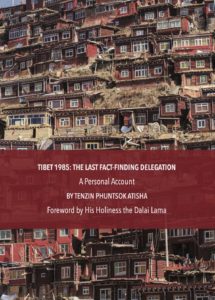
Published as an e-book by Australia Tibet Council in August 2020, “Tibet 1985: The Last Fact-Finding Delegation” by Tenzin Phuntsok Atisha is a personal account of his historic tour to Tibet in 1985 as a young official and as a member of the fourth and the final Tibetan fact-finding delegation to Tibet.
From the Australia Tibet Council website:
Tenzin Phuntsok Atisha, the former Representative of the Dalai Lama to Australia from 2003-2009, dedicated his life to serving the Central Tibetan Administration, popularly known as the Tibetan Government-in-Exile in Dharamsala, northern India.
A major highlight of his long career was being part of a historic tour to Tibet in 1985. As a young official, he was appointed as a member of the fourth and the final Tibetan fact-finding delegation to Tibet.
In 1979, the Chinese Government and the Tibetan Government-in-Exile first made direct contact when Deng Xiaoping met Gyalo Thondup, the elder brother of His Holiness the Dalai Lama and said his government is willing to enter into dialogue with Tibetans and that “apart from independence, all issues can be discussed”. This paved the way for four fact-finding delegations to Tibet in 1979 and 1985. However, all four delegations returned with the accounts of the wholesale destruction of Tibetan language, religion, culture and environment under China’s rule.
“The Royal History of Sikkim: A Chronicle of the House of Namgyal”

Published in June 2021 by Serindia Publications, “The Royal History of Sikkim: A Chronicle of the House of Namgyal”, was written in Tibetan at the turn of the 19th century by the then ruler, Chogyal Thutob Namgyal and his Tibetan Queen-consort Yeshe Dolma. It is a unique work of local history, presenting an alternative narrative to accounts of their Himalayan state written by contemporary British officials arguing the viewpoints of imperial India.
From the Serindia website:
The small mountain kingdom of Sikkim was founded in the mid-17th century as an ethnically diverse Buddhist monarchy intimately tied to Tibet. The Royal History of Sikkim dramatically tells the story of how, over the following centuries, their country survived pressure from more powerful states on all sides. Finally, during the 19th century, Sikkim came within the protective orbit of British India, whose rulers would act on Sikkim’s behalf against its enemies only if the Chogyal adhered to their mandates to serve as a commercial gateway into Tibet.
A preliminary translation of this important work of Himalayan history was written in 1909 – 1910 by the Sikkimese scholar Kazi Dawasamdup, well-known to Tibet specialists. However, following the demise of the royal couple, and as political alliances changed, the original Tibetan manuscript was set aside until being first published in 2003. The English translation, meanwhile, was never completed or published until now.
“Tibet Brief 20/20” By Michael van Walt van Praag and Miek Boltjes
From the book description:
The authors first convincingly show that, contrary to what Beijing claims and to what many people take for granted, Tibet was historically never a part of China, and Beijing does not have the right to rule Tibet and exploit its resources. They do so by thoroughly debunking China’s narrative created to justify its sovereignty over Tibet. The result of their historical and legal analysis is not only a new appreciation of Tibet, but also a new understanding of the Mongol and Manchu empires as well as China.
Next the book demonstrates that both Tibet’s occupation and Beijing’s suppression of the Tibetans’ right to self-determination are serious violations of international law, and that all states have an obligation to help end the seven-decade Sino-Tibetan conflict.
Tibet Brief 20/20 is a call to action. The result of ten years of collaborative research, and benefitting from the authors’ intimate understanding of the Sino-Tibetan conflict and efforts to resolve it, the book is a must read and indispensable reference for policy makers, civil society advocates and Asia specialists.
Available on Amazon here: https://amzn.to/2UOUFBZ
“Tibet in Chains: The Stories of Nine Tibetan Nuns”
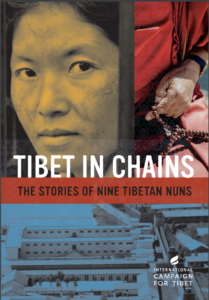
Published as an e-book by the International Campaign for Tibet in February 2021, “Tibet in Chains: The Stories of Nine Tibetan Nuns” are the stories of nuns who bravely resisted China’s oppression through nonviolent protests and patriotic songs, even as they endured horrific abuse in prison.
From the ICT website:
In the book, each nun tells her own tale in her own words. All nine of them now live in free countries around the world, having left Tibet at various times and under various circumstances.
Eight of them—Gyaltsen Dolker, Yeshi Dolma (who goes by the ordained name of Ngawang Rigdol), Ngawang Sangdrol, Rinzin Choekyi, Rinzin Chonyi, Phuntsog Nyidron, Sonam Choedon and Thinley Choezom—are now former nuns. Only Palden Choedon remains a nun, studying in a nunnery in India.
In the 1990s, all nine of them were part of the “Drapchi 14,” also known as the “Singing Nuns.” This group earned praise from around the globe for its courage and solidarity in China’s notorious Drapchi prison in the Tibetan capital of Lhasa.
In “Tibet in Chains,” the nine women describe their families and early lives in Tibet—which China has brutally occupied for more than 60 years—as well as their dedication to their Tibetan Buddhist nunneries. Most of them were part of Garu nunnery near Lhasa.
As China’s crackdowns on religious freedom and human rights made life ever more difficult for Tibetans, the young nuns—some of them just teenagers—decided to raise their voices against the Chinese government.
After they took part in peaceful demonstrations, each nun was arrested and eventually sent to Drapchi.
Download the book from the ICT website here: https://savetibet.org/wp-content/uploads/2021/02/ICT-Tibet-in-Chains.pdf
“The Frontier Complex: Geopolitics and the Making of the India-China Border, 1846–1962” By Kyle J. Gardner
Published by Cambridge University Press in January 2021, “The Frontier Complex” reveals the transformation of the historical Himalayan entrepôt of Ladakh into a modern, disputed borderland through an examination of rare British, Indian, Ladakhi, and Kashmiri archival sources.
From the Cambridge University Press website:
Kyle J. Gardner provides both a history of the rise of geopolitics and the first comprehensive history of Ladakh’s encounter with the British Empire. He examines how colonial border-making practices transformed geography into a political science and established principles that a network of imperial frontier experts would apply throughout the empire and bequeath to an independent India. Through analyzing the complex of imperial policies and practices, The Frontier Complex reveals how the colonial state transformed, and was transformed by, new ways of conceiving of territory. Yet, despite a century of attempts to craft a suitable border, the British failed. The result is an imperial legacy still playing out across the Himalayas.
Available from Bookshop here: https://uk.bookshop.org/a/4863/9781108840590
“Nehru, Tibet and China” By Avtar Singh Bhasin
From the Penguin India website:
On 1 October 1949, the People’s Republic of China came into being and changed forever the course of Asian history. Power moved from the hands of the nationalist Kuomintang government to the Communist Party of China headed by Mao Tse Tung. All of a sudden, it was not only an assertive China that India had to deal with but also an increasingly complex situation in Tibet which was reeling under pressure from China.
Clearly, newly independent India, with Prime Minister Jawaharlal Nehru at its helm, was navigating very choppy waters. Its relations with China progressively deteriorated, eventually leading to the Indo-China war in 1962. Today, more than six decades after the war, we are still plagued by border disputes with China that seem to routinely grab the headlines. It leads one to question what exactly went on during those initial years of the emergence of a new China. And, more importantly, why have we repeatedly failed to arrive at a solution?
Available on Amazon here: https://amzn.to/3zATfda
Anthropology, Ethnography and Science
“Taming the Poisonous: Mercury, Toxicity, and Safety in Tibetan Medical Practice” By Barbara Gerke
Note: This title is open access

Published by Heidelberg University Publishing in April 2021, “Taming the Poisonous” is an ethnographic and socio-historical account uncovering how toxicity and safety are expressed transculturally in a globalizing world.
From the Heidelberg University Publishing website:
For the first time, the book unpacks the “pharmaceutical nexus” of mercury in Tibetan medicine (Sowa Rigpa) where, since the thirteenth century, it has mainly been used in the form of tsotel. Tsotel, an organometallic mercury sulfide compound, is added in small amounts to specific medicines to enhance the potency of other ingredients. In concordance with tantric Buddhist ideas, Tibetan medical practitioners confront and tame poisonous substances, and instead of avoiding or expelling them, transform them into potent medicines and elixirs.
Recently, the UN Environment Programme’s global ban on mercury, the Minamata Convention, has sparked debates on the use of mercury in Asian medicines. As Asian medical traditions increasingly intersect with biomedical science and technology, what is at stake when Tibetan medical practitioners in India and Nepal, researchers, and regulators negotiate mercury’s toxicity and safety? Who determines what is “toxic” and what is “safe,” and how? What does this mean for the future of traditional Asian medical and pharmaceutical practices?
Download the e-book via this link.
“Mapping Amdo: Dynamics of Power” Edited by Ute Wallenboeck, Bianca Horlemann, and J. Ptáčková
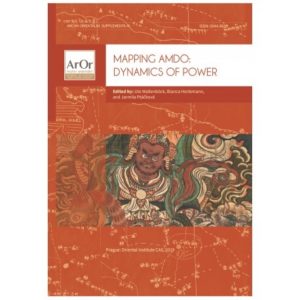
Published by Prague’s Oriental Institute in 2019, the second volume of Mapping Amdo – “Dynamics of Power” edited by Ute Wallenboeck, Bianca Horlemann, and J. Ptáčková addresses cultural and political spheres of influence and discusses economic, cultural, and sociopolitical aspects of power as executed by various players throughout Amdo history.
Throughout the history of Amdo, representatives of both the secular and the religious communities have engaged in power struggles within their own communities as well as in confrontation with each other. Apart from military or spiritual power, which were distinct from the traditional positions of chieftains and clerics, this volume also discusses economic, cultural, and sociopolitical aspects of power as executed by various players throughout Amdo history.
The volume follows on from “Mapping Amdo: Dynamics of Change”.
Available via the Prague Oriental Institute.
Three titles by John V. Bellezza
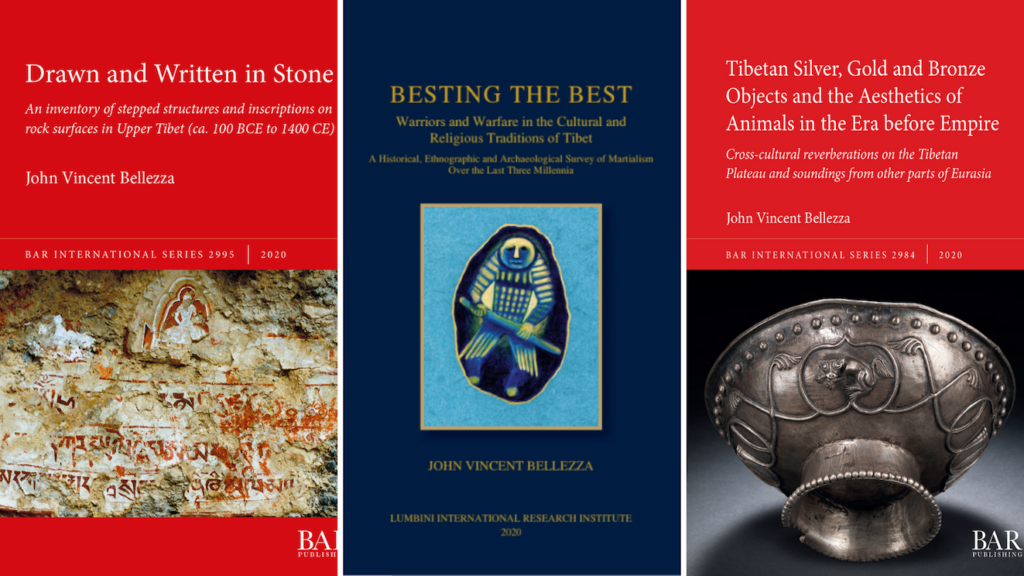
These three titles by archaeologist and cultural historian John Vincent Bellezza are historical, ethnographic and archaeological studies of Tibet.
“Besting the Best: Warriors and War in the Religious and Cultural traditions of Tibet. A Historical, Ethnographic and Archaeological Study on the Nature of Martial Activities over the Last Three Millennia” was published in 2020 by Lumbini International Research Institute and is available via Vajra Books.
“Drawn and Written in Stone: An Inventory of Stepped Shrines and Early Rock Inscriptions in Upper Tibet (ca. 100 BCE to 1400 CE” was published in 2020 by BAR Publishing and is available on Bookshop here: https://uk.bookshop.org/a/4863/9781407356396
“Tibetan Silver, Gold and Bronze Objects and the Aesthetics of Animals in the Era before Empire: Cross-cultural Reverberations on the Tibetan Plateau and Soundings from other Parts of Eurasia” was published in 2020 by BAR Publishing and is available on Bookshop here: https://uk.bookshop.org/a/4863/9781407354316
Younger Audiences
The Four Harmonious Friends མཐུན་པ་སྤུན་བཞི། By Tsering Manee (Author), Tenzin Tendhar (Illustrator), Tashi Sonam (Translator)
Newly interpreted with vivid illustrations and linguistically adapted to our time, this book inspires children and adults to reflect. Bilingual for reading aloud and as a first reading book.
Available in Tibetan in two bilingual editions, English and Tibetan and German and Tibetan.
“The Extraordinary Life of His Holiness the Fourteenth Dalai Lama: An Illuminated Journey” By His Holiness The Dalai Lama, Rima Fujita
Published by Wisdom in July, in “The Extraordinary Life of His Holiness the Fourteenth Dalai Lama: An Illuminated Journey”, His Holiness the 14th Dalai Lama tells the story of his life with stunning illustrations by artist Rima Fujita.
From the Wisdom website:
One of the most revered spiritual figures of our time—His Holiness the Fourteenth Dalai Lama—tells the story of his life in this intimate, timeless, and approachable book. Featuring luminous illustrations from world-renowned artist Rima Fujita and some never-before-shared details, it’s the perfect way to explore the life of the Dalai Lama. This simple yet powerful text combined with stunning artwork will captivate readers of all ages—and will take you on a mystical journey you won’t soon forget.
Available on Bookshop here: https://uk.bookshop.org/a/4863/9781614297499
“The Snow Leopard’s New Friend: Tibetan Animal Tales” By Michael Buckley
From the book description:
Set against the majesty of the Tibetan plateau, these tales aim to inspire conservation—and draw attention to the environmental problems of Tibet. A section at the back provides real profiles of the animals featured, along with another section on activities and activism. Illustrated with artwork and photography, these tales convey an eco-message about the need to live in harmony with nature, not fighting against it.
Suitable for children aged 8 and up.
Available on Amazon here: https://amzn.to/3kZ5HiT
“The Little Book of Encouragement” By His Holiness The Dalai Lama
Published in May 2021 by Penguin Random House India and edited by Renuka Singh, in this volume, His Holiness shares words of encouragement to deal with new realities in a pandemic stricken world.
Available on Bookshop here: https://uk.bookshop.org/a/4863/9780670094943
“This Fragile Planet: The Dalai Lama on Environment” By Michael Buckley

Available via the Apple Books platform, this digital photobook was published in December 2020. “This Fragile Planet” features 80 inspiring quotations from His Holiness the Dalai Lama on environment, matched with 120 eye-catching photos and visuals from a dozen professional photographers — all carefully curated and edited by Tibet expert Michael Buckley.
From the book’s description:
An ethical approach to dealing with the urgent issues of climate change and taking care of our delicate ecosystems.
The book lays out the vision of His Holiness concerning secular ethics and environmental protection, great respect for all living beings, the importance of interdependence, and the concept of universal responsibility for protecting Mother Earth. The Dalai Lama’s 1989 Nobel Peace Prize was the first ever awarded on the basis of environmental protection. Over the decades since, His Holiness has worked tirelessly as an environmental activist, making this one of his key commitments in life. He is a staunch advocate of the value of education of the heart — the need for compassion and ethics, inspiring the coming generations — and has worked closely with educators to realise this vision.
Available via Apple Books: https://books.apple.com/gb/book/this-fragile-planet/id1542505313

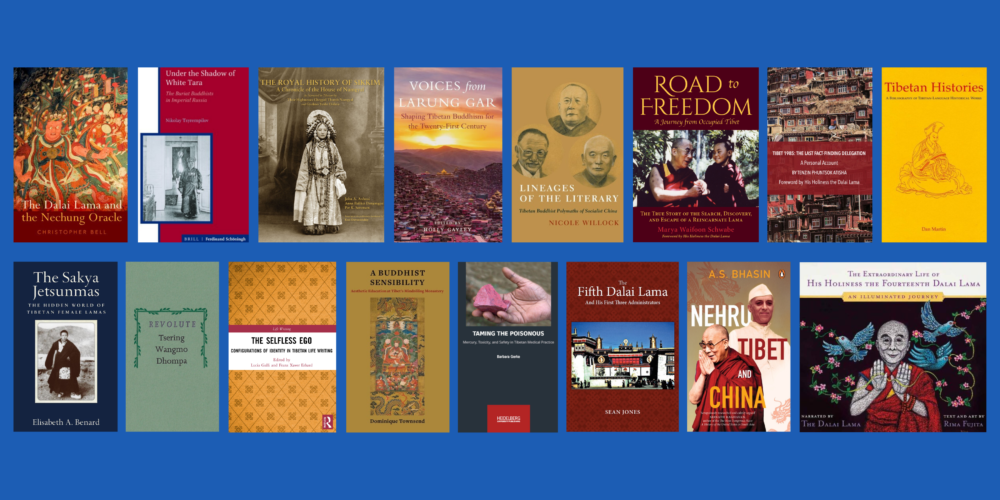
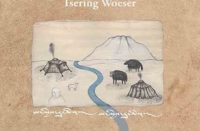
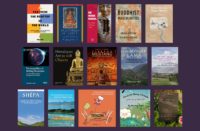

Follow Us!